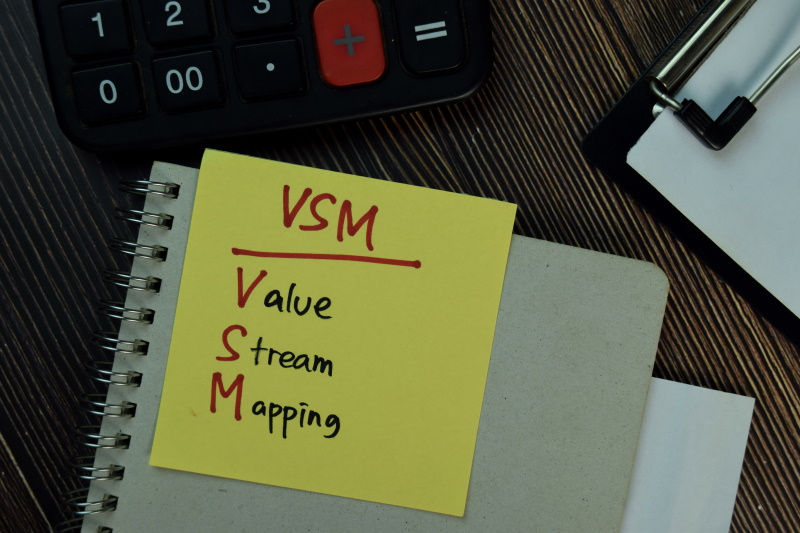Value Stream Management is the culmination of Lean business process evolution taking place over more than 30 years. Following this evolution, the term is now beginning to make its way into common business parlance at an accelerating rate. At its core, Value Stream Management aims to improve operational efficiency and simultaneously reduce waste thereby maximizing the value of products delivered. The achievement of these goals can be expected to result in improved customer value which in turn generates increased revenue.
From iSixSigma:
“If you were to list all the steps, activities, and tasks that occur from the time your process starts until it ends, that list would contain both value-added and non-valued elements.
We can define value added as those steps or activities that add value in the eyes of the customer. Value added is … also is defined as those activities that your customer is willing to pay for — and are done right the first time.”
Forbes describes Value Stream Management as offering “a unique view of the software delivery life cycle through the customer experience lens”. For some businesses, this can require a step back from the status quo to re-align around the new viewpoint; in some cases this re-alignment also requires cross-cutting communication between teams or departments that are currently siloed.
Value Stream Management (VSM) has become such an important topic that leaders from across the software development landscape came together earlier this spring to form the Value Stream Management Consortium (VSMC) to “create and foster a community of experts to further VSM practices, innovation, and adoption,” said Helen Beal, Chair of the Value Stream Management Consortium. Additionally, the VSMC produced “The State of Value Stream Management Report”, which is available for download.
Value Stream Mapping
“Value Stream” refers to a process of steps that an organization uses to deliver value to customers of the organization, but how do businesses identify and define their value streams? Through a process called Value Stream Mapping.
“Whenever there is a product for a customer, there is a value stream.” (Learning to See)
Implementing Value Stream Mapping is straightforward:
- Create a map of the current product state – this captures the existing production process through delivery to the customer
- Create a map of the ideal future state – this is both aspirational and theoretical because it is not yet known what process may deliver the greatest value
- Devise an action plan – these are the steps that will take the product from the current state to the future state
In addition to these three outputs, Value Stream Mapping has several beneficial side effects:
- determine where value is
- determine where value is not
- improve efficiency by identifying and eliminating waste and bottlenecks
- improve product quality
- define each team’s contribution to product value
- strongly encourage cross-team collaboration
Although the thrust of Value Stream Mapping is to maximize the product value returned, it is not uncommon for businesses to also find significant value in breaking down cross-team and cross-department barriers – a necessary step for effective Value Stream Mapping and Value Stream Management. Improved communication can provide business value by ensuring that each team is aligning the objectives of their work to a larger goal – such as producing products or features that are built to the correct specifications required by an adjacent team. An additional benefit of breaking down barriers is that teams understand their respective roles in producing final products which can help to drive greater job satisfaction.
Relation to DevOps
If we think about DevOps as a set of practices by which to deliver value while simultaneously being positioned to quickly pivot when requirements – determined by value – change, then having a language and process for accurately tracking, analyzing, and evaluating the output of DevOps makes sense. In this regard, VSM is a natural extension of the DevOps ecosystem.
DevOps culture with integrated Value Stream Management can lead to significant improvements in efficiency and cost reduction, especially through digital transformation. This may take different forms for different businesses, but a symbiotic relationship – where VSM informs DevOps objectives and DevOps teams respond by re-prioritizing and delivering features – is likely to deliver consistently positive results for many businesses. Although sponsorship for VSM sometimes originates at an executive level, this is not a requirement for success.
Value Stream Management and Digital Transformation
As a part of digital transformation, Value Stream Management arms everyone from individual contributors up through top executives with the language and insight necessary to properly direct effort in order to maximize the value output. This return comes in many forms, from reducing total project time – or viewed alternatively as the time to delivery of solutions – to reducing operating expense (OpEx) to maximizing revenue from selling new products.
Another way to think about this synergy is that VSM brings the functionality of A-B testing (also known as split testing or bucket testing) to business processes and with the same value proposition – quickly identify the highest value option and then use those results to inform execution. From New Context, “Often, business value is driven by delivering invaluable customer experiences against critical timelines. CIO’s are therefore looking to invest in platforms which can increase visibility across their distributed teams and enhance their control over their highest value enterprise digital transformation projects. Increasingly, Boards also expect visibility into how quickly critical customer digital experiences are unlocked and increased monitoring of business impact, risk, and resilience.”
Logically VSM is shifting business conversations from a matter of “what” – as in “what needs to be done” – to “why” – as in “why is a certain product the highest value option”. By asking why, businesses not only establish which products are of the highest value, but also set the stage for a planning phase of future products – such as when a product is not currently the highest value but might be second or third highest and will become the highest value at a time in the future. This benefit depends entirely on all stakeholders fully investing in VSM because evaluating value without the input of the entire organization at best paints only a part of the picture.
Value Stream Management Solutions
Plutora offers a Value Stream Management platform solution to act as the “catwalk above the factory floor” with features spanning value stream identification, planning, release, and deployment for software development. Plutora supports numerous integration options, including an API for DevOps.
Kovair uses a top-down approach for their Value Stream Management platform offering, starting with the customer’s voice and using that data to inform value definitions. This leads to visualizations of Value Streams and insights into which improvements best optimize value. The Kovair Rest API is a great option for DevOps teams looking to tightly couple VSM with other Agile activities.
Broadcom ValueOps supports digital transformation at scale by “integrating the proven investment planning features of Clarity with the advanced Agile management capabilities of Rally software” to combine business- and investment-oriented product management. From service virtualization to testing to model archives, Broadcom supports a wide range of functionality via API.
ServiceNow offers a suite of tools to cross Information Technology Service Management (ITSM), Operations Management (ITOM), Business Management (ITBM), Governance, and Risk and Compliance. The combination of these offerings serves to support the broad range of tasks necessary for successful Value Stream Management. Supporting this wide array of utilities, ServiceNow also offers API’s for each capability.
Digital.ai aims to combine DevOps and Value Stream Management insights into a single integrated platform – as they say “full visibility, full stop”. Gartner has also ranked Digital.ai as a leader for Enterprise Agile Planning Tools and users have appreciated the “Ability to define value streams, strategic themes and portfolio epics”; “option to track the milestone and generating Gantt charts”; and “Easy Epics and user story creation”. Digital.ai opens their API for teams to integrate and extend the capabilities of their platform.
Conclusion
Increasing the value of products delivered might be reason enough to consider Value Stream Management as a practice, especially for the enterprise, however, the benefits don’t stop with the product and extend to reductions in cost, improvements in efficiency, more effective DevOps cycles, better communication throughout the organization, and increased understanding of each team member’s role. By following a straightforward pattern of analyzing the current state, imagining an optimal future state, and creating a plan to go from former to latter – as well as an enterprise-wide commitment to the journey – any business can begin to reap the rewards of Value Stream Management. To make matters simpler, several vendors are already innovating in the space and offer products to help organizations throughout the phases of the Value Stream Management adoption lifecycle.



